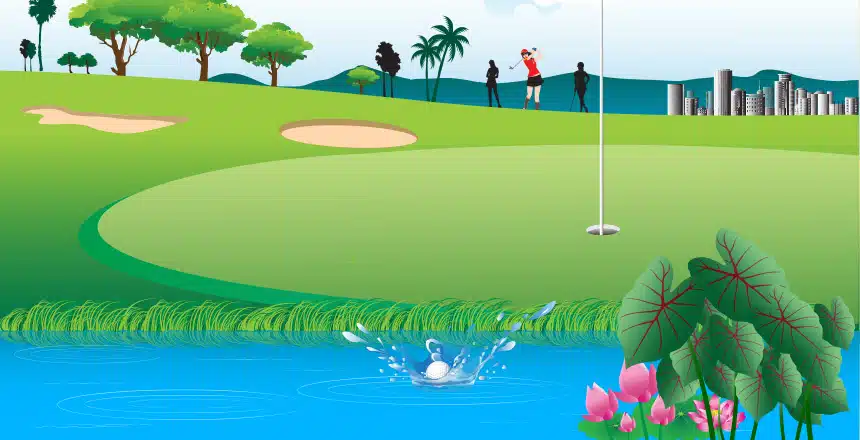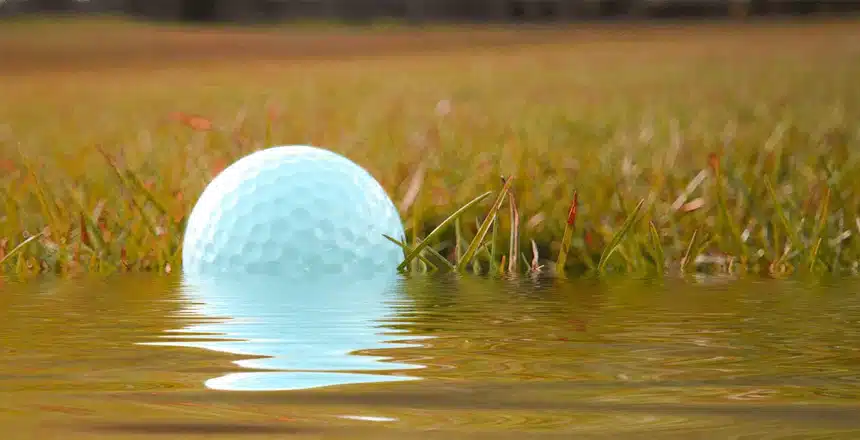It’s pretty common for golf balls to land in the lake or come in contact with rain, humidity, wet greens, etc. So the main question is can golf balls get waterlogged?
Yes, they do get waterlogged, and very easily. A golf ball submerged in water is highly susceptible to becoming waterlogged anywhere between 6 hours and 12 hours. Naturally, the waterlogging will have an impact on the ball quality, which just means it’s not going to fly as it did before all that waterlogging.
If it’s one of these low-cost golf balls, you don’t have to worry about it. But if you’re using premium quality golf balls, you may be looking at the money going to waste.
Knowing the answer to the main question could also be important because maybe you’re purchasing used golf balls and just want to ensure they’re not filled with water. Because if they are waterlogged, it’s best to buy brand new ones.
Related:
In This Post
Can Golf Balls Get Waterlogged?

Golf balls can get waterlogged, and they certainly will if they find themselves at the bottom of a lake for anywhere from 6–12 hours.
The design of a golf ball consists of a protective outer coating, which doesn’t have the ability to prevent water from entering through micro-cracks. Hence, moisture will seep into the ball if it has these micro-openings.
Although don’t worry so much about natural factors like rain and humidity damaging your precious golf balls. If you know how to dry them properly after every round of golf you play, they’re good to go for a long time till they actually get waterlogged.
Waterlogging, as I mentioned before, is a result of the ball being submerged in water for 6 hours to 12 hours. And there’s no point trying to dry them after – a waterlogged golf ball is a lost cause, so it should just be thrown away.
How Do Waterlogged Golf Balls Perform?
If you’re wondering does water affect golf ball performance, the answer is a big, fat YES.
There’s no way that a golf ball with water inside it is going to help you ace your performance on the turf. A ball like this does not compress much and, at the same time, doesn’t even fly too far. Even more so if the golf ball has been in the water for years or even months!
If you know anything about ball flight laws, then you already know that waterlogged golf balls will not produce the type of shots you desire (because they don’t bounce as high as dry golf balls). Trajectory and spin also get affected due to the heavier weight and wetness. Thus, an undesirable or unfavorable topspin/backspin is generated.
Is It Okay to Play with Waterlogged Golf Balls?
On the one hand, there are the best used golf balls because recycled golf balls are actually a big business now. On the other hand, there are retrieved golf balls that are not okay to use.
If a ball that’s been fetched out of a lake looks and feels much the same as one that wasn’t submerged in water, it’s perfectly fine for gameplay. That golf ball is less likely to even have a noticeable impact on performance.
At the same time, also keep in mind that water manages to get through the outer protective layer of golf balls. And once in, it’s going to mess with the mechanics and construction of the ball. As a result, how far it flies will get affected.
Now if you’re a low handicapper or scratch golfer, you have what it takes to elevate your performance on your own. However, at the same time, you’ll also want to be using top-quality golf balls that have not spent time in a lake.
What Goes Wrong with Waterlogged Golf Balls?
Nothing is wrong if your brand new golf ball ends up in a lake. A fresh ball is more likely to not have any scratches or cracks in it, hence water is not allowed to seep through. Even if this ball spends a long time, like a few weeks or even several months, submerged in water like that, no damage is done.
But a used golf ball tells an entirely different tale. It’s going to have some cracks in it, thus allowing water to penetrate its core and mess things up.
When golf balls have been lying in water for anywhere between 6 and 12 hours, they’re going to get waterlogged. And that means no more spring-like effect that makes them fly as high and far as they do. You’re looking at a loss distance of at least 20 yardages or so – now that’s a huge decrease in the distance!
Frequently Asked Questions
Does Water Spoil Golf Balls?
Water will only ruin a golf ball if it’s a used ball with scratches and cracks. When golf balls with such micro-openings sit in water for too long, they’re decreed to get waterlogged. Water seeps in and enters the core, dampening its ability to fly HIGH and LONG.
How Long Before Golf Balls Get Waterlogged?
How long can a golf ball last in water you ask? Well, that actually depends on a lot of factors.
If it’s a used golf ball with tinny fissures, then it’s sure to get waterlogged in less than 6–12 hours. As for an unused or new ball, it can remain in a lake for weeks and even months without showing any signs of damage.
Does A Waterlogged Golf Ball Weigh More?
Once water makes its way into a golf ball, the weight of the ball is bound to increase because of the added mass.
Should You Use Lake Golf Balls?
It’s not recommended, as these golf balls have often been soaked in water for long periods of time, hence they could be damaged. However, if you still choose to use them, make sure to inspect them thoroughly first and take required steps like drying them out before playing.
When’s the Right Time to Discard Golf Balls?
Do golf balls go bad? Yes, they do.
But how to tell if a golf ball is still good? If it doesn’t have a cracked cover and if it doesn’t produce a fainter sound on impact. Then that means the ball is perfectly fine to use. Otherwise, it needs to be thrown away because of the noticeable change in appearance and sound.
Conclusion
Because of modern technology, golf balls are now built with a highly protective outer layer, which does an excellent job of preventing water from entering the interior. That is why a brand new, unused golf ball remains unharmed even after spending months in a lake.
But a used version of that, with scratches and cracks, is no more immune to waterlogging. So when buying used golf balls, make sure they’ve not been fetched out of water. Because these kinds of damaged balls can’t have stay unharmed for too long in the water.

